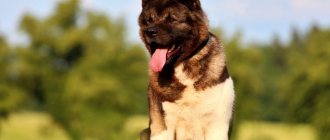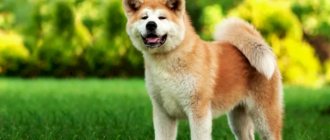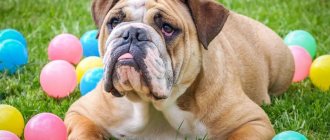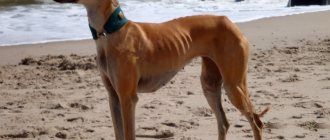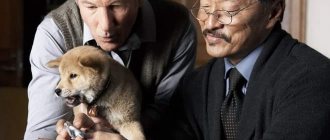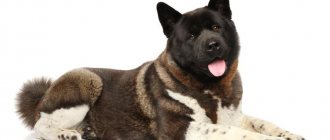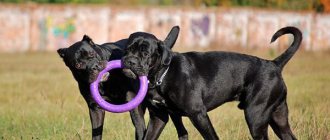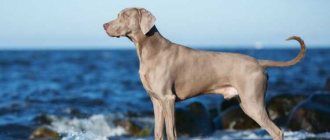| Type |
|
| Size | giant (more than 50kg) |
| Main features |
|
| Included in |
|
| Frequent illnesses |
|
| Intelligence | 70% |
Video American Akita
The American Akita is a strong dog that combines the best traditions of the sophisticated East and the pragmatic West. The breed received dignity from the unyielding samurai and courage from the first settlers of America. It’s impossible not to fall in love with the bear-cute American Akita at first sight. But upon closer acquaintance, you understand: this dog is not as simple as it seems.
Those who have been captivated by the delightful American Akita dog should take into account that she has a complex character. Not everyone can understand it. This self-sufficient beast is ready to make friends with a worthy person, but will never submit to him completely. The American Akita's habits resemble a cat that walks on its own. She is also independent, self-sufficient and calm if left alone.
You will find more information about the unusual and charming American Akita dog breed below.
History of the American Akita breed
The American Akita is one of the breeds that appeared relatively recently, in the last century. But the Japanese ancestors of these dogs have a long history. Back in the 17th century, tall Matagi dogs were known on the island of Honshu. They hunted large game with humans, guarded the owner’s home and fought in fierce duels with each other. Later, the breed was given a different name in honor of the Akita province, where such dogs were especially popular.
The beauty and courage of the Akita were noticed at the Japanese imperial court. These dogs received elite status. They began to be kept in noble houses. Pedigree puppies were given for merit and as a sign of special favor. Akita was surrounded with honors and solemn rituals, and their own servants were assigned to the animals. And for killing dogs they could be sentenced to death.
At the same time, in Japan, in areas where ordinary people lived, dog fights with Akitas continued to be held. To make the fighters stronger and stronger, they began to cross them with other large breeds: mastiffs, mastiffs, bulldogs. Refined Japanese dogs gradually began to change their appearance. They became larger and more powerful.
In 1908, dog fighting was banned. When the fighting Akitas were left without work, the owners began to get rid of unnecessary dogs, throwing them out onto the street. The breed was on the verge of extinction. But in 1931, Akita was taken under state protection. The best representatives of the breed were recognized as natural monuments.
Then the Second World War struck a blow to the dog population. The thick fur almost killed the Akita, and clothing for the army began to be made from animal skins. Obstinate Japanese dogs did not master military professions well, so priority was given to service breeds. Akita lovers hid their pets, and they also began to crossbreed them with German shepherds.
After the end of the war, the breed was divided into eastern and western lines. Japanese breeders began to restore the original characteristics of the dog. And in the United States of America, the emergence of a new format of Akita began.
Dogs from Japan, which the American military brought home, quickly became popular. The overseas breed captivated its new owners with its intelligence, endurance and original, slightly wild appearance. However, it was not possible to preserve the previous image of the Akita. Japanese and American dog breeders could not find a common language to continue breeding together.
As a result of adding the blood of shepherds and mastiffs to dogs brought from Japan, a new breed was formed - the American Akita, with its own characteristics and characteristics. In 1952, an association of breed lovers was registered in the United States, and 20 years later it was recognized by the American Association of Kennel Clubs (AKC). But for some time the western and eastern lines were not separated at exhibitions. Only in 1999, with the approval of the Federation Cynologique Internationale (FCI), did the American Akita gain full independence. She was officially separated from the Japanese Akita Inu.
Breeding history
The beautiful name can be translated into Russian as a dog native to the Akita province. It is worth noting that the breed has a history of several thousand years, which is confirmed by the finds of archaeologists and the conclusions of specialists in the field of history. The Japanese hunting breed of four-legged Matagi Inu became the ancestor of the Akita.
The 17th century is characterized by a huge variety of dogs intended for hunting, but there was a clear shortage of dogs with guard qualities. That is why they tried to shape the new breed in the right direction. It is worth noting the successes of breeders in this field. Akita Inu gained popularity at the court of the emperor himself and over time moved into the category of the elite, becoming inaccessible to commoners. The peculiarity of this breed is confirmed by the decree of one of the rulers of Japan that anyone who commits an attempt on such a dog will face the death penalty or imprisonment.
Gradually, the popularity of the Akita increased and the nobility began to provide personal servants for the dogs. Communication with the animal should not have taken place in a raised tone, and expressions characteristic of commoners were also not allowed.
But everything flows and changes, representatives of this breed began to be used to participate in battles, fun and other entertainment events, which served to gradually spread the animals throughout the country.
The main rival in dog fighting can be called Molossians, who are distinguished by their large size, strength and endurance. So that Akitas could compete with them, a series of indiscriminate crossings began with large representatives of canines from Europe, which almost destroyed purebred dogs.
With the beginning of the twentieth century, selection work began to restore the purebred breed. This happened due to the concern of the Japanese authorities about the current situation. However, the Second World War broke out, during which everyone forgot about the revival of the Akita, and after hostilities were over, the situation became completely catastrophic. Noble Japanese families who still had purebred dogs were able to influence the situation, only thanks to them it was possible to continue the restoration of the breed.
Interesting fact. The American military brought representatives of this breed to the United States, which contributed to the creation of a new branch. But this breed is not recognized by Japanese dog handlers.
American Akita dog appearance
The American Akita has inherited some of the external characteristics of its older sister, the Akita Inu. But still, dogs of these breeds are quite different in appearance. Even the least attentive person can easily find many differences.
The Japanese Akita Inu is a large but slender and graceful dog and comes in only red, white or brindle colors. The American Akita is about the same height, but much more massive and stronger. And almost any color is allowed. There are plenty of options. If we draw an analogy with wild animals, then the Akita Inu is more like a light fox, and the American Akita is closer to a seasoned wolf.
The American Akita is a large and stocky dog. Her maximum height is 71 centimeters, and her weight can reach up to 65 kilograms. Her appearance is typical of huskies: erect ears and a donut tail. But the figure is heavier and more substantial, closer to a square in format.
The dog has a massive head; when viewed from above, it is clear that it has the shape of an obtuse triangle. The skin is wrinkle-free and fits tightly to the skull. The transition between the forehead and muzzle is clearly visible. The nose is large, preferably with a black nose. The jaws are strong with a level or scissor bite. The dark brown eyes are medium-sized, in the shape of a triangle. They look smart and a little cunning. The eyelids are pigmented and tightly fitting. Small ears stand firm and slightly tilted towards the eyes. It seems that the dog is listening carefully.
The neck of the American Akita is muscular and rather short. The scruff is noticeably pronounced, the dewlap is insignificant. The body is only slightly longer than the height at the withers, the back is level, the loin is strong. The chest is well developed, and the stomach is tucked, but not very significantly, but moderately. The fluffy tail is quite massive. It is located high and is necessarily wrapped in a ring, completely or three-quarters, sometimes a double “donut”. This complex “structure” is thrown over the back or held along the body. If the tail is unfolded, it should reach the hock joint.
The limbs of the American Akita are powerful and smooth. The thighs are muscular, clad in fluffy pants. The paws are soft and elastic like a cat.
The American Akita dog, especially in puppyhood, has a very funny fifth point. Of course, she is not as plump and fluffy as a corgi, but she is also quite cute. Akitas not only wag their tails, but also swivel their hips while walking.
The American Akita runs easily and powerfully, without effort. The back remains level during movement.
The surface coat of this breed is straight and harsh. The dense, soft undercoat makes the dog look fluffy. The hair is shorter on the head and ears, and on the lower limbs. On the neck and rump the hair is approximately 5 cm long; on the hips and tail the hairs are thicker and longer.
There are many color options. American Akitas can be red, fawn, black, white, piebald, spotted, brindle and a combination of different colors. There is often a dark mask on the muzzle, sometimes a light mark. The color of the undercoat may not match the color of the outer coat.
The disadvantages of the breed include deviations from the standard exterior and the following features:
- muzzle too narrow;
- lack of teeth;
- spotted tongue;
- light iris;
- shortened tail;
- elbows turned in any direction;
- feathering on the ears and paws or collar.
Faults that lead to disqualification include these characteristics: excessively light bone structure, nose without pigmentation or with uncolored areas, floppy ears, problems with bite, sickle-shaped tail that does not form a ring. Timid and overly aggressive representatives of the breed are excluded from participation.
Description of appearance
Akita Inu were originally used by monks to guard and protect monasteries 3,000 years ago and were strictly careful to ensure that the breed did not get outside the monastery walls. Then the local population adapted dogs for hunting large animals (boar, bear).
Akita Inu is the smallest of the Japanese hunting dogs, but far from the smallest among its relatives. Her height at the withers is 61-67 cm, weight 40-50 kg. For those living in high-rise buildings, it is not very comfortable to have a dog of this size in an apartment, so a smaller copy of it was produced, the appearance of which corresponds to the original, but half the size. The small Akita is called like a Shiba Inu. Translated from Japanese, it means “little bush dog.”
Main characteristics of the Shiba Inu:
- body – muscular, somewhat elongated;
- height – 38-40 cm;
- weight – up to 10 kg;
- back – straight, strong;
- neck – muscular, strong;
- head – has a wide skull;
- chest – wide, ovoid;
- nose – black;
- eyes – dark brown, slightly slanted, almond-triangular in shape;
- ears – medium size, erect;
- the coat is straight, thick, hard, needle-shaped with a soft undercoat;
- paws – strong, muscular, the angle between the humerus and the front paws is 110-120 degrees;
- the tail is strong, curled into a ring. It is not allowed to untwist the ring, lower the tail or lay it on the dog's croup.
Best Bernese Mountain Dog
Breed standard
The small Akita has a mostly red coat color, but white and brindle are also acceptable. The tiger color can range from a light silver shade to almost black. Black and tan dogs have a bright white butterfly on their chest.
Important! The red coat color can have different shades from light sesame, red sesame (blackening of the fur at the tips) to bright red.
The Mini Hachiko breed has a distinctive feature – urajiro. This means that the area of the chest, belly, lower neck and tail, cheeks, chin, and inner surface of the paws are white. The transition from light to dark color should be gradual.
Character of the American Akita
A proper American Akita should have a friendly and courageous character, as stated in the standard. In addition, it says that this is an obedient companion dog, but with a sense of self-esteem.
It is no coincidence that the American Akita became proud and self-confident. Her ancestors were made this way by life itself. During the hunt, the dog could be left alone with a wild animal, which was often stronger than it. Then we had to make decisions on our own without regard to the person. Modern dogs have inherited “independence of thought” from their ancestors. It is this quality that people who have previously only interacted with service breeds mistake for stubbornness. And sometimes the American Akita is even mistakenly attributed to poor learning ability. However, when compared with Japanese relatives, she is more flexible and obedient.
Dogs of this breed are quite calm and balanced, and they are also smart. Therefore, it is comfortable to live with them. As experienced owners of American Akitas assure, their pets behave with restraint and are not intrusive, and do not get in the way. That is, they do not require special attention. The Akita will rejoice at the owner’s arrival, say hello, and then go about his business. Perhaps to some this behavior seems devoid of emotion. But lovers of the breed believe that this is a big plus - the American Akita, despite its large dimensions, is completely invisible and does not interfere.
The American Akita should not be aggressive towards people. But at the same time, the dog has good guard qualities. She will calmly and closely watch strangers at home and on the street. If nothing threatens the owner and his family, the dog will not lose balance. But if there is any potential threat, it will manifest itself.
Please note that American Akitas bark extremely rarely; they only give voice on important matters. These dogs are silent. They inherited “taciturnity” from their Japanese ancestors. In a calm state, they prefer a “cordial” conversation to loud barking. The Akita will tell you about its needs and concerns with strange sounds: purring, mooing or something similar.
With members of the household, the American Akita is the kindest creature. In the family she is affectionate and plush, she can get along well with children and play with them. But it is better not to leave a large dog with a very small child. She won’t intentionally harm him, but she might do something accidentally. It's a beast after all.
The American Akita easily gets along with other pets under the same roof. But only if you are used to them from early childhood. She may not accept the new family member; you need to introduce them very carefully. Dogs of the same sex are enemies for the American Akita. She reacts especially poorly to large dogs. Although she rarely starts a fight herself, she fights brutally and can seriously injure her opponent. Interestingly, dogs of this breed easily recognize their fellow dogs and treat them more tolerantly than others.
American Akitas can remain alone for quite a long time without any problems. They will not howl or whine. Only at a young age will puppies become mischievous if they are left unattended. To prevent this from happening, you need to provide them with toys. And adult dogs are even happy when they are not bothered. They love to sleep alone and take a break from the hustle and bustle.
This breed also inherited its legendary loyalty from Japanese dogs. American Akitas become very attached to one owner and have difficulty changing families. Therefore, before getting a pet, you need to think carefully about whether you need such a dog or whether it is a momentary desire.
Which owner is it suitable for?
Before purchasing a dog, the future owner should carefully study the description of the Akita Inu and its character.
Despite its unpretentiousness in maintenance, competently raising a pet of this breed will require a lot of effort and time, as well as tenacity of character and a willingness to spend on the services of a trainer.
In addition, the future owner must lead an active lifestyle, love frequent walks and be able to communicate a lot with his pet.
Pros and cons of the American Akita breed
American Akitas are not easy dogs, but they have a lot of positive qualities. However, some pros and cons depend on your upbringing. If a dog is raised correctly, it will display the best traits of the breed:
- Developed intelligence
- Brave character
- Guarding instinct
- Ability to build relationships with children
- Calm and equanimity
- Taciturnity
- Devotion
- Spectacular appearance
- Wool is almost odorless
- Cleanliness.
The American Akita breed has few problematic characteristics, these include:
- Independent and self-reliant character
- Love of freedom
- Large dimensions
- Selectivity in nutrition.
Breed characteristics
- Aggressiveness: Moderate ( Overall score
3/5) - Activity: High ( Overall score
4/5) - Training: Average ( Overall score
3/5) - Shedding: High ( Overall score
4/5) - Need for care: Medium ( Overall score
3/5) - Friendliness: Average ( Overall score
3/5) - Health: Average ( Overall score
3/5) - Cost of maintenance: Above average ( Overall score
4/5) - Attitude towards loneliness: Moderate time ( Overall score
3/5) - Intelligence: Smart ( Overall score
4/5) - Noise: Almost inaudible ( Overall score
1/5) - Security qualities: Good ( Overall score
4/5)
Education and training
The American Akita breed causes a lot of controversy. Some people confess their love for this dog and consider it an ideal. And others say that the decision to get one was a mistake; communication with a pet brings them not joy, but grief. Everyone has their own story and truth. The clear conclusion is this: this dog is not for beginners and is absolutely not suitable for an owner with a very soft and pliable character. And we must also take into account that you should not humanize your four-legged pet. No matter how cute and “plush” he looks, we must not forget that he is a strong and intelligent animal, and it is very difficult to understand what is on his mind.
Let us remind you: the American Akita has a wayward character. For a dog to become manageable, it needs a calm and consistent owner. Raising a puppy should begin as soon as it opens its eyes and continue continuously. Rules, especially prohibitions, must be established once and for all and never broken. If you allow retreat, then the dog will do as he wants. For example, you did not allow the puppy to jump on the sofa. But one day they took pity on him and allowed him to lie there. After that, he will violate the ban again and again, and you will not be able to explain what he is doing wrong.
An important skill is dog socialization. From an early age, puppies should be accustomed to different sounds and other stimuli, they should be taken for walks (of course, after full vaccination) along crowded streets, and introduced to guests, other dogs and animals. The sooner the puppy was introduced into the world, the calmer he will be later.
Command training also needs to start as early as possible. First of all, master what is useful in everyday life: nickname, place, toilet, commands “walk”, “come to me”. It would be good to take a general training course, this will make it easier to control a large dog. By the way, the American Akita learns lessons better than the Japanese Akita. Still, the relationship with German shepherds plays a role. By the way, the American Akita does not like the fetch command and does not really like playing with the ball.
Some puppies will perform any trick and will give their souls for something tasty. And for others, the best motivation will be the praise and affection of the teacher.
These big fluffies are happy to learn freestyle and agility, although they are inferior in speed to more nimble breeds. But dog handlers advise not to rush into mastering the protective guard service. The American Akita will instinctively guard its territory without any training. But until she is two years old, she should not be taught to show aggression towards people. This dog is intended to be a companion and should be friendly. Therefore, the psyche of a young dog may not withstand a change in the genetic program.
Many American Akita owners claim that the most important thing is not training, but close contact with the pet and its trust. However, this is what is most difficult to achieve. The owner must become an indisputable authority for the dog, the leader of the pack. But you will have to gain respect without violence and shouting. Independent and proud Akitas will not tolerate rude treatment. You can influence them only with love, patience and firmness.
Breeders of this breed do not recommend giving the dog to a dog handler for training alone without an owner. They should only practice in pairs, so that the person understands his pet and is able to recognize its signals. If it is possible to establish close contact, the American Akita will begin to respond not so much to the owner’s commands as to his words, gestures and even glances.
Care and maintenance
The American Akita is best kept in a private house or an enclosure attached to it. They adapt well to any weather conditions and are not afraid of either significant frost or heat. But you will have to make sure that the area is securely fenced. These dogs, especially when they are young, prefer unauthorized walks. They can easily jump over a small fence or dig under a hole if the height is not manageable.
American Akitas love winter very much. They rejoice in the frost and the first snow, swim in the snowdrifts, frolic and jump tirelessly. And they endure the summer heat steadfastly and patiently, finding the coolest place and dozing there all day.
An American Akita can also live in an apartment. Of course, if the owners are not embarrassed by the large size of the pet. But, as a rule, the dog does not bother people too much; it usually sleeps quietly for most of the day.
In the city, we need to pay more attention to physical activity and walking. A young dog should go for walks more often, but an adult will only need to go out twice a day to take care of toilet matters. But Akita needs to move actively for at least half an hour, this way it will maintain health and physical fitness. She doesn’t need too intense training; she’s not a working dog with overflowing energy. The American Akita is a powerful, but rather sedentary dog. Although she has decent stamina. She can run 10 kilometers while accompanying a cyclist. But you can only load this way on an adult dog (over one and a half years old), and not a puppy.
An American Akita puppy should not walk on stairs until one year of age; this is extremely harmful to the spine and joints. Be sure to ride in the elevator with him. And if it is not there, you will have to carry the pet in your arms.
Grooming and hygiene
The American Akita has a delightful fluffy coat. But her coat is very easy to care for. Between shedding, the dog needs to be brushed a couple of times a week. During a coat change (this happens twice a year), the procedure is carried out daily, or better yet, twice a day.
The dog does not need frequent bathing. In addition, the coat of this breed cleans itself and has almost no smell; American Akitas rarely go dirty. And they are washed only when they get dirty or on the eve of an exhibition.
In addition to grooming, it is necessary to regularly carry out hygiene procedures. You should make it a rule to inspect and clean your Akita's ears and eyes about once a week. At least once a month, brush your teeth with a special veterinary paste. Nails should be trimmed as they grow.
Feeding
Most American Akita breeders give their pets dry food. In their opinion, natural food is too difficult to select and troublesome to prepare. But you can’t skimp on food. You need to carefully choose a brand, study reviews from other amateur and professional dog breeders. The best choice for an Akita is a food with medium protein and fat content. There should be no soy, corn, wheat or other similar fillers in the composition. You shouldn’t skimp on quality, otherwise your dog may have health problems. And treatment will cost much more.
The powerful and heavy American Akita requires vitamins and minerals to maintain a strong skeleton and overall health. Regardless of the type of food, an adult dog should be given a multivitamin course every six months. Young dogs are recommended to be given collagen and chondroprotectors to form bones and strengthen joints.
The basis of the natural diet of the American Akita should be raw meat, which is first frozen. Vegetables and fruits will be a source of fiber and carbohydrates; they can be given fresh or lightly boiled. Under no circumstances should you feed your Akita “human” food, especially sweet, spicy and smoked food. Don't get too carried away with dog treats and treats. Food for the animal must be closer to the natural diet that the animal can obtain in the wild.
What to feed
At home, the Akita Inu ate exclusively light and low-fat food - fish, seaweed, rice. It is not easy to create such conditions for nutrition in our country, so the breed is considered problematic in this regard.
Akitas are big allergy sufferers. If you prefer commercial food, please note that most of these foods contain soy, to which Akitas are allergic. Therefore, it is necessary to choose high-quality and expensive food without adding this ingredient.
What foods should be included in a dog's diet?
- Meat . At least 50% percent of the daily volume. You can give exclusively lean meats and fish.
- Offal . They give only boiled liver, kidneys, and lungs.
- Porridge . You can give rice, buckwheat, millet. You may be allergic to corn and oats. It is better not to feed them to your Akita.
- Vegetables . Boiled pumpkin, zucchini, and carrots are best given with a small amount of vegetable oil for better absorption of vitamins.
- Fruits . Dogs over 4 months old can be given apples, bananas, and pears.
- Low-fat fermented milk products . Feed only natural yoghurts and kefir without sweeteners or flavoring additives.
- Eggs . You can give no more than 2 pieces per week.
Selecting a diet may take a long time, since allergies to some foods are possible. Be patient and observant and you will succeed.
The volume of natural food should be no more than 10% of the dog’s weight, and the amount of industrial food is prescribed on the packaging. The frequency of feedings depends on age. If puppies up to 2 months eat 5-6 times a day, then Akitas from 6 months and older eat 2 times a day.
Health and illness
The American Akita is a dog that usually does not complain about its health and lives on average up to 15 years. But she has a heavy figure, so one of the genetic problems of the breed is joint dysplasia. Breeders are required to test the parent pair for predisposition to this disease.
American Akitas endure even painful veterinary procedures with heroic patience. They have a very high pain threshold.
These dogs have allergies. The most dangerous allergens are chocolate, grapes (raisins), onions, nuts and seeds. Moreover, sometimes the reaction occurs not only to food. Some Akitas cannot tolerate their own fur during shedding.
How to care for a dog
Akita Inu is distinguished not only by price, but also by its demandingness, so next we will discuss care and maintenance. You will learn the necessary information to help you raise a healthy friend for the whole family.
Behind the wool
The dog must be brushed at least once a week, and during shedding, you should use the brush at least 3-4 times, otherwise the dog will lose its appearance, and you will have to clean hairs from carpets and upholstered furniture.
Today, there are entire “canine beauty” salons that provide grooming—comprehensive care for a dog’s appearance, which includes combing, bathing, and cutting.
For cleanliness
The dog is bathed several times a year if it is kept at home, or when it gets dirty if it is in a yard or enclosure.
You need to bathe in warm water without using shampoos, as the latter can cause serious problems with the skin and coat. You need to dry the wool with a hairdryer, combing it during the drying process.
Behind the eyes, ears, claws, ears
Ear care. It is enough to check the sinks and clean them several times a month. If any swelling, spots appear, or the dog is in pain during examination, then you need to contact a veterinarian.
Eye care. The breed is predisposed to eye diseases, so if cloudiness, swelling occurs, or if the dog cannot open its eyes completely, immediately contact a specialist.
Dental care. To prevent your dog’s teeth from deteriorating, you need to buy special pressed gelatin bones, which can be purchased at any pet store.
It is important to understand that silicone or plastic bone will not replace gelatin and will not give an identical effect
Claw care. If the dog is kept in a yard or in an enclosure, provided that it is lined with hard material, the claws will wear off on their own, however, at home, the claws can grow to a dangerous length and your pet will either have difficulty moving or begin to scratch furniture and the floor in order to grind off claws Therefore, you need to trim your nails several times a week and monitor their growth.
Activity
An Akita cannot do without physical activity, as we talked about earlier, so you need to walk the animal in the morning and evening, and also try to spend as much time as possible on weekends or during vacation.
Lack of exercise will make the dog's ligaments weak and will also affect his mental health, so if you are not going to exercise the animal, you should not buy it. A hunting dog cannot become a completely domestic dog, even if you spend a huge amount of time on training.
Walking and exercising with your dog helps instill in it the rules of treating other animals, the owner and strangers. An Akita, which is left only to its own devices, can grow up to be an aggressive, unbalanced, headstrong dog that will not listen to you, and if brute force is used, it will harbor a grudge and take revenge. Considering all this, it is worth understanding that a purebred dog requires proper upbringing and training.
How to choose an American Akita puppy
If you want to get a puppy and are thinking about choosing a breed, there is a reason to take a closer look at the American Akita. But keep in mind that this dog should not be owned by an inexperienced person. In addition, you need to assess your financial capabilities. Keeping a large dog is a very expensive pleasure. And also answer the question whether you will have enough time to raise and socialize your pet.
Even if you answered yes to the previous questions, do not make a choice based on the dog's external characteristics. Be sure to go to exhibitions and go to the nursery to get to know the American Akita better. Talk to breeders and owners of these dogs. Ask for an honest opinion about the breed. Only then will you get the full picture and understand whether the American Akita is right for you.
A large dog puppy should be taken from an official kennel, even if you do not plan to exhibit it later. This ensures that your pet will not only have the external characteristics of the breed, but also a healthy psyche.
American Akita cubs resemble teddy bears. A good puppy should have a large head with dark eyes, small ears and a tail curled over its back. He will show courage and curiosity.
Pay attention to the puppy's compliance with breed standards. Check the condition of your eyes and ears especially. If they are dirty or inflamed, this is a sign of illness. A healthy puppy has fluffy, bright fur, is well nourished and moves easily.
And one of the most important selection criteria is that the future pet should arouse your sympathy, and ideally, your sympathy as well. It is important that you find your soul mate.
Photo
Akita Inus are not popular in Russia and you don’t see them every day. Therefore, those who want to admire these amazing animals are invited to this section, where their photos are presented. Wise eyes, good nature – that’s what you’ll notice first. Akita Inu puppies are even more endearing: they are fluffy, soft lumps, similar to lumps, and different in color from adult animals. Place next to a photo of an Akita Inu as a child and as an adult - and the changes are amazing. Instead of a black or gray mask, you will find a white mask on an adult Akita.
Even in the photo, the Akita leaves no one indifferent. The dog combines intelligence, wisdom, loyalty, beauty, character and independence. And all this is surprisingly conveyed in the expression of the eyes and muzzle. Watch and enjoy!
How much do American Akita puppies cost?
You can buy an American Akita puppy for an average of 30-50 thousand rubles, these are the prices of kennels. Offspring from titled champions will cost almost twice as much, they can cost 80,000-90,000 rubles.
If you are not going to show your dog, but want to get one for fun and friendship, pay attention to American Akita puppies with some deviations from the standard canons. These dogs are classified as "pets" and are offered at a lower price.
But don’t buy a kitten based on an ad on the Internet from unknown manufacturers and for a very cheap price. Most likely, they will sell you a mixed breed puppy that is very similar to a purebred puppy. It is unclear who will grow out of it in the end. Or an even worse option - the scammers will lure you out of money, promise to deliver the dog and disappear.
Choosing a puppy
In Russia, Akita is a fairly rare breed; even its Japanese counterparts are more common. When choosing a puppy, you will have to look for a reputable kennel with good reviews and trust. Breeders will help you choose a puppy for specific purposes: for exhibitions, protection, friendship.
When visiting a nursery, you should definitely look at the baby’s parents - their behavior, appearance - many traits will be passed on to the offspring.
The puppy itself must have a healthy appearance, shiny coat, be well-fed, and meet the breed standard.
Until the baby reaches 9 months, he is not assigned an exhibition class.
Activity and curiosity are the main signs of a healthy puppy. If your young Akita is acting lethargic, it may be a sign of health or mental problems.
